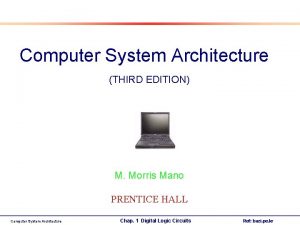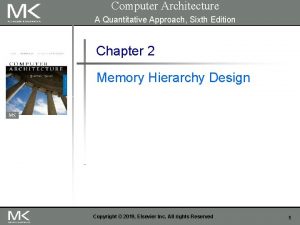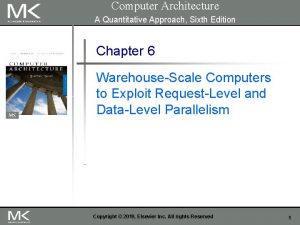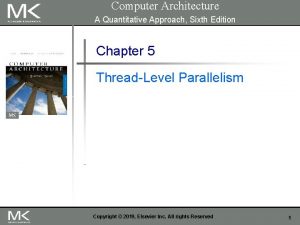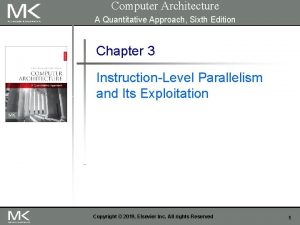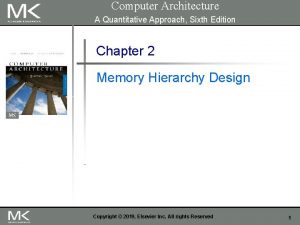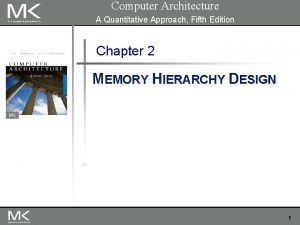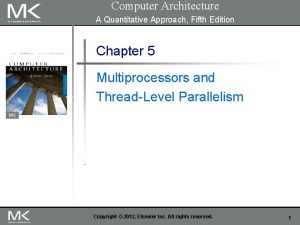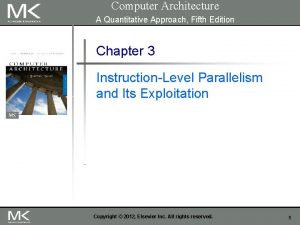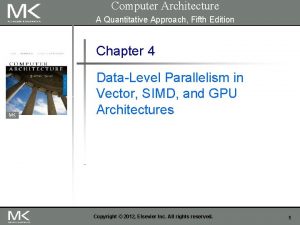Computer Architecture A Quantitative Approach Sixth Edition Chapter



































- Slides: 35

Computer Architecture A Quantitative Approach, Sixth Edition Chapter 5 Thread-Level Parallelism Copyright © 2019, Elsevier Inc. All rights Reserved 1

n Thread-Level parallelism n n n Introduction Have multiple program counters Uses MIMD model Targeted for tightly-coupled shared-memory multiprocessors For n processors, need n threads Amount of computation assigned to each thread = grain size n Threads can be used for data-level parallelism, but the overheads may outweigh the benefit Copyright © 2019, Elsevier Inc. All rights Reserved 2

n Symmetric multiprocessors (SMP) n n n Introduction Types Small number of cores Share single memory with uniform memory latency Distributed shared memory (DSM) n n n Memory distributed among processors Non-uniform memory access/latency (NUMA) Processors connected via direct (switched) and nondirect (multi-hop) interconnection networks Copyright © 2019, Elsevier Inc. All rights Reserved 3

n Processors may see different values through their caches: Copyright © 2019, Elsevier Inc. All rights Reserved Centralized Shared-Memory Architectures Cache Coherence 4

n Coherence n n n All reads by any processor must return the most recently written value Writes to the same location by any two processors are seen in the same order by all processors Consistency n n Centralized Shared-Memory Architectures Cache Coherence When a written value will be returned by a read If a processor writes location A followed by location B, any processor that sees the new value of B must also see the new value of A Copyright © 2019, Elsevier Inc. All rights Reserved 5

n Coherent caches provide: n n n Migration: movement of data Replication: multiple copies of data Cache coherence protocols n Directory based n n Sharing status of each block kept in one location Snooping n Centralized Shared-Memory Architectures Enforcing Coherence Each core tracks sharing status of each block Copyright © 2019, Elsevier Inc. All rights Reserved 6

n Write invalidate n n On write, invalidate all other copies Use bus itself to serialize n n Write cannot complete until bus access is obtained Centralized Shared-Memory Architectures Snoopy Coherence Protocols Write update n On write, update all copies Copyright © 2019, Elsevier Inc. All rights Reserved 7

n Locating an item when a read miss occurs n n In write-back cache, the updated value must be sent to the requesting processor Cache lines marked as shared or exclusive/modified n Only writes to shared lines need an invalidate broadcast n Centralized Shared-Memory Architectures Snoopy Coherence Protocols After this, the line is marked as exclusive Copyright © 2019, Elsevier Inc. All rights Reserved 8

Copyright © 2019, Elsevier Inc. All rights Reserved Centralized Shared-Memory Architectures Snoopy Coherence Protocols 9

Copyright © 2019, Elsevier Inc. All rights Reserved Centralized Shared-Memory Architectures Snoopy Coherence Protocols 10

n Complications for the basic MSI protocol: n Operations are not atomic n n E. g. detect miss, acquire bus, receive a response Creates possibility of deadlock and races One solution: processor that sends invalidate can hold bus until other processors receive the invalidate Extensions: n Add exclusive state to indicate clean block in only one cache (MESI protocol) n n Centralized Shared-Memory Architectures Snoopy Coherence Protocols Prevents needing to write invalidate on a write Owned state Copyright © 2019, Elsevier Inc. All rights Reserved 11

n Shared memory bus and snooping bandwidth is bottleneck for scaling symmetric multiprocessors n n n Duplicating tags Place directory in outermost cache Use crossbars or pointto-point networks with banked memory Copyright © 2019, Elsevier Inc. All rights Reserved Centralized Shared-Memory Architectures Coherence Protocols: Extensions 12

n Every multicore with >8 processors uses an interconnect other than bus n n n Makes it difficult to serialize events Write and upgrade misses are not atomic How can the processor know when all invalidates are complete? How can we resolve races when two processors write at the same time? Solution: associate each block with a single bus Copyright © 2019, Elsevier Inc. All rights Reserved Centralized Shared-Memory Architectures Coherence Protocols 13

n Coherence influences cache miss rate n Coherence misses n True sharing misses n n n Write to shared block (transmission of invalidation) Read an invalidated block False sharing misses n Read an unmodified word in an invalidated block Copyright © 2019, Elsevier Inc. All rights Reserved Performance of Symmetric Shared-Memory Multiprocessors Performance 14

Copyright © 2019, Elsevier Inc. All rights Reserved Performance of Symmetric Shared-Memory Multiprocessors Performance Study: Commercial Workload 15

Copyright © 2019, Elsevier Inc. All rights Reserved Performance of Symmetric Shared-Memory Multiprocessors Performance Study: Commercial Workload 16

Copyright © 2019, Elsevier Inc. All rights Reserved Performance of Symmetric Shared-Memory Multiprocessors Performance Study: Commercial Workload 17

Copyright © 2019, Elsevier Inc. All rights Reserved Performance of Symmetric Shared-Memory Multiprocessors Performance Study: Commercial Workload 18

n Snooping schemes require communication among all caches on every cache miss n n Limits scalability Another approach: Use centralized directory to keep track of every block n n n Which caches have each block Dirty status of each block Implement in shared L 3 cache n n Keep bit vector of size = # cores for each block in L 3 Not scalable beyond shared L 3 Copyright © 2019, Elsevier Inc. All rights Reserved Distributed Shared Memory and Directory-Based Coherence Directory Protocols 19

n Alternative approach: n Distribute memory Copyright © 2019, Elsevier Inc. All rights Reserved Distributed Shared Memory and Directory-Based Coherence Directory Protocols 20

n For each block, maintain state: n Shared n n Uncached Modified n n n One or more nodes have the block cached, value in memory is up-to-date Set of node IDs Exactly one node has a copy of the cache block, value in memory is out-of-date Owner node ID Directory maintains block states and sends invalidation messages Copyright © 2019, Elsevier Inc. All rights Reserved Distributed Shared Memory and Directory-Based Coherence Directory Protocols 21

Copyright © 2019, Elsevier Inc. All rights Reserved Distributed Shared Memory and Directory-Based Coherence Messages 22

Copyright © 2019, Elsevier Inc. All rights Reserved Distributed Shared Memory and Directory-Based Coherence Directory Protocols 23

n For uncached block: n Read miss n n Write miss n n Requesting node is sent the requested data and is made the only sharing node, block is now shared The requesting node is sent the requested data and becomes the sharing node, block is now exclusive For shared block: n Read miss n n The requesting node is sent the requested data from memory, node is added to sharing set Write miss n The requesting node is sent the value, all nodes in the sharing set are sent invalidate messages, sharing set only contains requesting node, block is now exclusive Copyright © 2019, Elsevier Inc. All rights Reserved Distributed Shared Memory and Directory-Based Coherence Directory Protocols 24

n For exclusive block: n Read miss n n Data write back n n The owner is sent a data fetch message, block becomes shared, owner sends data to the directory, data written back to memory, sharers set contains old owner and requestor Block becomes uncached, sharer set is empty Write miss n Message is sent to old owner to invalidate and send the value to the directory, requestor becomes new owner, block remains exclusive Copyright © 2019, Elsevier Inc. All rights Reserved Distributed Shared Memory and Directory-Based Coherence Directory Protocols 25

n Basic building blocks: n Atomic exchange n n Swaps register with memory location Test-and-set n n Synchronization Sets under condition Fetch-and-increment n Reads original value from memory and increments it in memory n Requires memory read and write in uninterruptable instruction n RISC-V: load reserved/store conditional n If the contents of the memory location specified by the load linked are changed before the store conditional to the same address, the store conditional fails Copyright © 2019, Elsevier Inc. All rights Reserved 26

n Atomic exchange (EXCH): try: n mov x 3, x 4 lr x 2, x 1 sc x 3, 0(x 1) bnez x 3, try mov x 4, x 2 ; mov exchange value ; load reserved from ; store conditional ; branch store fails ; put load value in x 4? Synchronization Implementing Locks Atomic increment: try: lr x 2, x 1 addi x 3, x 2, 1 sc x 3, 0(x 1) bnez x 3, try ; load reserved 0(x 1) ; increment ; store conditional ; branch store fails Copyright © 2019, Elsevier Inc. All rights Reserved 27

n Lock (no cache coherence) lockit: n addi x 2, R 0, #1 EXCH x 2, 0(x 1) bnez x 2, locket Synchronization Implementing Locks ; atomic exchange ; already locked? Lock (cache coherence): lockit: ld x 2, 0(x 1) bnez x 2, locket addi x 2, R 0, #1 EXCH x 2, 0(x 1) bnez x 2, locket ; load of lock ; not available-spin ; load locked value ; swap ; branch if lock wasn’t 0 Copyright © 2019, Elsevier Inc. All rights Reserved 28

n Advantage of this scheme: reduces memory traffic Copyright © 2019, Elsevier Inc. All rights Reserved Synchronization Implementing Locks 29

Processor 1: A=0 … A=1 if (B==0) … n Should be impossible for both if-statements to be evaluated as true n n Processor 2: B=0 … B=1 if (A==0) … Delayed write invalidate? Sequential consistency: n Result of execution should be the same as long as: n n Models of Memory Consistency: An Introduction Models of Memory Consistency Accesses on each processor were kept in order Accesses on different processors were arbitrarily interleaved Copyright © 2019, Elsevier Inc. All rights Reserved 30

n To implement, delay completion of all memory accesses until all invalidations caused by the access are completed n n Reduces performance! Alternatives: n Program-enforced synchronization to force write on processor to occur before read on the other processor n Requires synchronization object for A and another for B n n Models of Memory Consistency: An Introduction Implementing Locks “Unlock” after write “Lock” after read Copyright © 2019, Elsevier Inc. All rights Reserved 31

n Rules: n X→Y n n Operation X must complete before operation Y is done Sequential consistency requires: n n Relax W → R n n “Total store ordering” Relax W → W n n R → W, R → R, W → W “Partial store order” Models of Memory Consistency: An Introduction Relaxed Consistency Models Relax R → W and R → R n “Weak ordering” and “release consistency” Copyright © 2019, Elsevier Inc. All rights Reserved 32

Copyright © 2019, Elsevier Inc. All rights Reserved Models of Memory Consistency: An Introduction Relaxed Consistency Models 33

n n n Consistency model is multiprocessor specific Programmers will often implement explicit synchronization Speculation gives much of the performance advantage of relaxed models with sequential consistency n Basic idea: if an invalidation arrives for a result that has not been committed, use speculation recovery Copyright © 2019, Elsevier Inc. All rights Reserved Models of Memory Consistency: An Introduction Relaxed Consistency Models 34

n n n Measuring performance of multiprocessors by linear speedup versus execution time Amdahl’s Law doesn’t apply to parallel computers Linear speedups are needed to make multiprocessors cost-effective n n Fallacies and Pitfalls Doesn’t consider cost of other system components Not developing the software to take advantage of, or optimize for, a multiprocessor architecture Copyright © 2019, Elsevier Inc. All rights Reserved 35
 Computer architecture a quantitative approach sixth edition
Computer architecture a quantitative approach sixth edition Computer architecture a quantitative approach sixth edition
Computer architecture a quantitative approach sixth edition Computer architecture a quantitative approach sixth edition
Computer architecture a quantitative approach sixth edition Computer architecture 5th edition
Computer architecture 5th edition Computer architecture a quantitative approach
Computer architecture a quantitative approach Computer architecture a quantitative approach
Computer architecture a quantitative approach Mmodation
Mmodation The sixth sick sheik's sixth sheep's sick lyrics
The sixth sick sheik's sixth sheep's sick lyrics Biochemistry sixth edition
Biochemistry sixth edition Automotive technology principles diagnosis and service
Automotive technology principles diagnosis and service Automotive technology sixth edition
Automotive technology sixth edition Citation sample pdf
Citation sample pdf Precalculus sixth edition
Precalculus sixth edition Principles of economics sixth edition
Principles of economics sixth edition Harris & harris digital design and computer architecture
Harris & harris digital design and computer architecture Morris mano computer system architecture
Morris mano computer system architecture Computer organization and architecture 10th edition
Computer organization and architecture 10th edition Computer architecture arm edition
Computer architecture arm edition Digital design and computer architecture: arm edition
Digital design and computer architecture: arm edition Bus design in computer architecture
Bus design in computer architecture Computer architecture and computer organization difference
Computer architecture and computer organization difference Complete computer description in computer organization
Complete computer description in computer organization Using mis 10th edition
Using mis 10th edition Chapter 1
Chapter 1 Define the concept of comparative education
Define the concept of comparative education Quantitative analysis approach
Quantitative analysis approach Quantitative approach to management
Quantitative approach to management Modes of speciation ppt
Modes of speciation ppt Transductive reasoning psychology
Transductive reasoning psychology Democritus atomic model diagram
Democritus atomic model diagram Systems architecture 7th edition
Systems architecture 7th edition Datagram networks and virtual circuit networks
Datagram networks and virtual circuit networks Theoretical models of counseling
Theoretical models of counseling Waterfall market entry strategy
Waterfall market entry strategy Multiple conflict
Multiple conflict Bandura's reciprocal determinism
Bandura's reciprocal determinism















